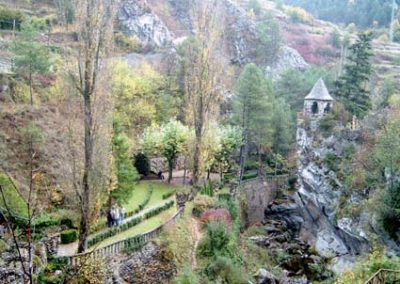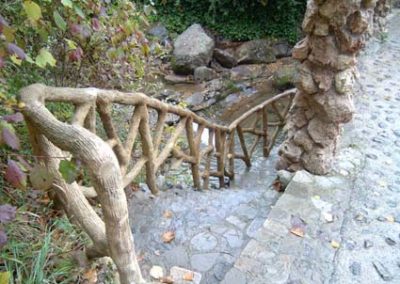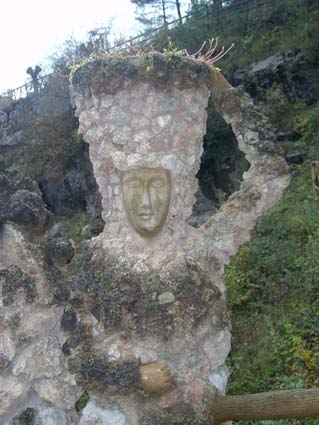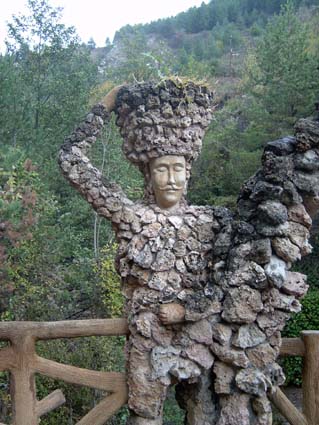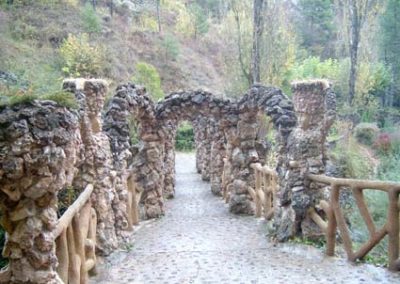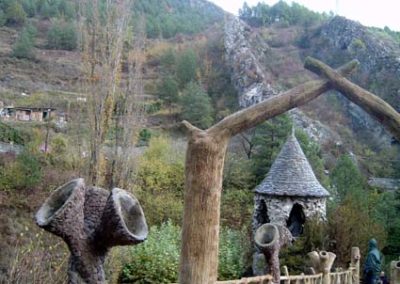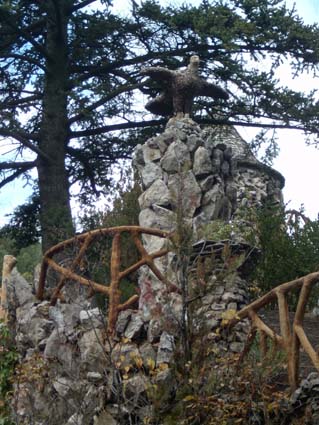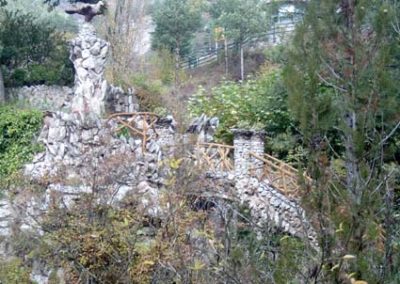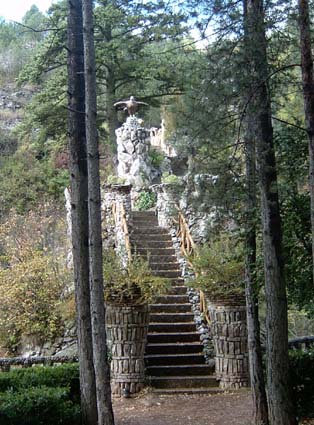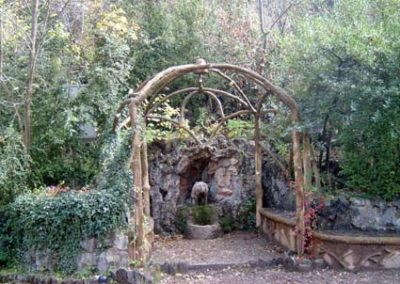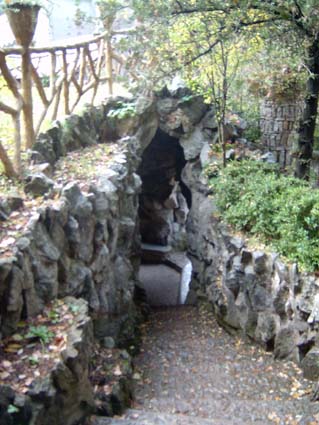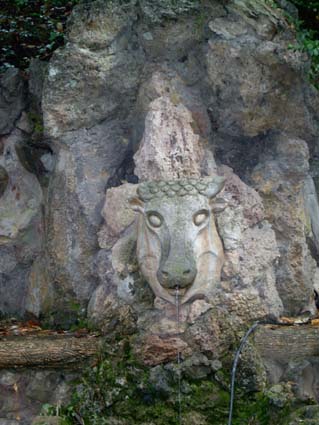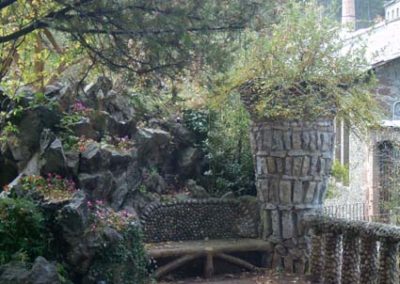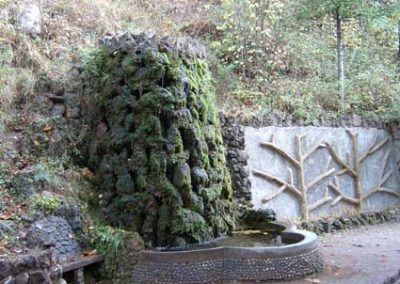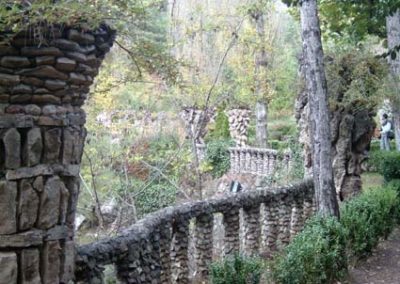Artigas Gardens
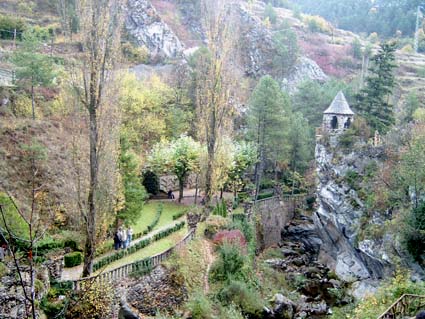
Basic Information
Location: Afores, s/n – Camí de la Pobla a Clot del Moro La Pobla de Lillet (Berguedà)
Qualification: xx (2 on 5)
Present condition: Very good, Gardens restored in 1992.
How to go to:
By car: La Pobla de Lillet is around 130 Km. from Barcelona and 70 Km. from Manresa, following the road C-16 arriving to Guardiola de Bergadà, take the road B-402 to La Pobla de Lillet. Being arrived to La Pobla take the street to the small train way and follow it to the Garden parking, from there walk around 200 meters to the Gardens gate.
By Bus: Through Alsina Graells Company call previously to the phone number 93 265 65 92. From Barcelona to Manresa, Berga and La Pobla de Lillet.
Manel Mir Vila Company call previously to the phone number 972 70 30 12. From Ripoll to Campdevànol and La Pobla de Lillet.
By train: RENFE, from Barcelona to Ripoll or Campdevànol, and from there by BUS through Manel Mir Vila Company (Phone number 972 70 30 12). Ripoll-Campdevànol-La Pobla de Lillet.
Visits: From 13 September to June:
Working days: Gardens are closed, but it is possible to ask for the key at the Tourist Office of La Pobla de Lillet from 10 to 14 and 16 to 18 hours.
Saturdays, Sundays and Holidays: from 10h. to 17h.
From July to September 12:
Mondays to Sundays: from 10h. to 19h.
Fees:
Individual visitor: 4 Euros.
Children from 4 to 14 years old: 2 Euros.
Children from 0 to 3 years old and members of Club Super 3 (Showing the card) Free.
Pensioners: 3,60 Euros.
Groups of more of 30 people: 3,20 Euros /person.
Scholar groups of more of 30 people: 2,50 Euros/person.
Commented visits with a guide are included in the entry fees for groups of more of 30 people.
Groups of less of 30 people 3,20 Euros/person. + 25,- Euros if a guided visit is needed.
Scholar groups with less of 30 children: 2,50 Euros/person + 25 Euros if a guided visit is needed.
Timings, prices and other information can vary, please verify it previously.
Available guides: It is possible to buy at the gate of the gardens the book “Gaudí in the Vall de Lillet) – writers: Joan Bassegoda, Ramon Espel and Roger Orriols, at a price of 15 Euros.
Handicapped accessibility: The garden important unevenness (stairs and pads) can seriously difficult the visits of handicapped people. Access not possible for wheelchairs.
Nevertheless, in special cases and under a previous request, it is possible to enter through the old factory, reducing some of the difficulties.
Information: Phone: (0034) 93 823 61 46 – email: [email protected]
Tourist office of La Pobla de Lillet: Parc Xesco Boix, s/n.
History
The start
These gardens were ordered to Gaudí by Joan Artigas i Alart (down photo *) during one of the stays the architect carried out in La Pobla de Lillet.
Gaudí took a first trip in the year 1902 to follow the evolution of the building work – the Catllaràs Villa. This chalet was an assignment to Gaudí by Eusebi Güell i Bacigalupi (Count of Güell and sponsor of Gaudí).
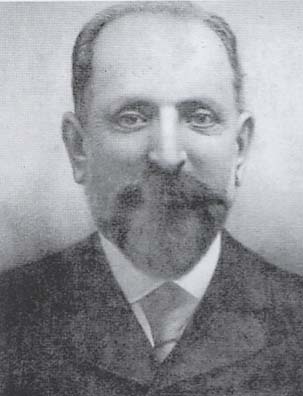
Artigas, a friend of Güell and owner of a textile factory, knowing the work of Gaudí in the Park Güell then in construction, he wanted to build a garden next to his factory in both sides of the river Llobregat that crossed his property.
Artigas was informed of the stay of the architect in La Pobla de Lillet and send to him a demand to have a meeting.
The fact is that in a subsequent trip of Gaudí to La Pobla de Lillet, Artigas sent a coach to collect Gaudí to the station of Ripoll and lodged the architect in his house.
Artigas asked to Gaudí for some sketches of the garden. After this stay in La Pobla de Lillet, Gaudí returned to Barcelona and …..
The construction:
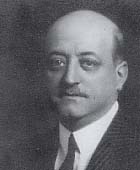
Gaudí, did not only carry out the sketches ordered by Artigas, but he also sent two bricklayers working in the Park Güell to help in the construction of the gardens and training the workers to follow the works once they return to Barcelona. After two months these two workers transferred the responsibility to the local bricklayers and back to Barcelona.
The works were developed since 1903 until 1910. During this period, at the ends of the year 1903, Joan Artigas i Alart, initial developer of the project, died.
Joan Artigas i Casas (photo to the right *), the son of Joan Artigas, followed the business activity and the construction of the garden.
The local workers continued the construction following the sketches of Gaudí to the project end.
Sadly, the mentioned original sketches aren’t arrived to us, because they burned in the fire of the factory at the end of the civil war (1939).
The abandonment:
Since the end of the works, the garden has passed, as usual, through various historic vicissitudes.
Because of the death of Joan Artigas i Casas in the year 1934 and the civil war initiated two years later, the garden was falling in the abandonment worsened by the fire of the factory before mentioned.
In the fifties, the family Artigas was transferred to Barcelona. During these years, the work of Gaudí and the modernism (Catalan Art Nouveau) were hardly criticized, first by the Noucentisme (the style following the Catalan Art Nouveau) and subsequently by architectural conceptions arriving even to propose the interruption of the works of the Sagrada Família.
The renaissance:
Until 1971 in which appeared in the newspaper of Barcelona “El Correo Catálán” a report titled “Gaudí in La Pobla de Lillet” no more interest on that gardens was manifested. In this writing, it was spoken on the Artigas Gardens, on the chalet del Catllaràs and on the chalet del Clot del Moro, suggesting that they were works of Gaudí.
This was the start of a new interest by these exceptional works that in spite of all, did not have been developed till the year 1982 in which a doctorate student of the Cátedra Gaudí -Josep Lluís Dalmau i Miralles- carried out a study including to draw up the designs of the gardens.
The next year -July 11, 1983 – the major of La Pobla de Lillet, Joan Casanova, and the brothers Costa Artigas -owners of the land-, signed a transfer agreement of the gardens by a period of 25 years for public use.
In 1989, the major of La Pobla, Josep Bober, entrusted to the Cátedra Gaudí the studies to edit a public park project developed by the architects Joan Bassegoda, Witold Burkiewicz and the technical architect Ramon Espel.
The works of restoration were itself carrying out little by little from the year 1992, respecting the initial idea of Gaudí, redoing all the sculptures and applying new techniques where it was necessary, as for example in the banisters substituting the interior wire nettings causing oxidation problems, by plastic nettings.
In all these actions the contribution of an extraordinary local bricklayer, Valentí Rovira, had been very important.
The present time:
At present, the garden presents an excellent aspect and is visited by numerous people enjoying the park alone or through commented visits.
Description
Generalities:
In comparison of another great garden of Gaudí, the Park Güell, which is a dry garden, the Artigas Gardens are humid gardens.
Really, the Gardens Artigas Gardens are very humid. They are crossed by the river Llobregat, they have a source, the “Source of the magnesia” (name by which also they are known) and they are found in a mountainous and humid place.
Another difference among both gardens is the character of urban park, of a very ordinate structure and of many open spaces although very adapted to the nature of the Park Güell, in contrast with the Gardens Artigas that are of naturalistic type, with few flowers, but only the natural flowers of that area and with an exuberant natural vegetation.
It seems as if here, Gaudí only wanted to simplify the men walk, avoiding the unnecessary changes in the nature.
The gardens Artigas are again, as all the works of Gaudí, a paradigm of originality and imagination visible in every corner of the work. But on the contrary of the Park Güell (with who we will not stop to do comparisons), the Artigas Gardens show a sobriety of colour that is the antithesis of the “trencadís” (decorative mosaic carried out with broken ceramic pieces) so frequent in the Park Güell. This sobriety is due to the utilization of the natural materials of the place, specially the natural rocky stone. By this reason, the predominant colours of these gardens are the stone brown and the vegetation green.
The entrance:
The access to the gardens is done at present by a new entrance close to the small train from La Pobla de Lillet to Clot del Moro.
Descending the stairs that carry us at the lower level of the gardens and continuing toward the left, by a walk that flanks the river with stone banisters and flower beds, we arrive at a waterfall of rustic stone covered with moss where the water slides.
Further on to the right it is the access to a bridge. But we continue straight ahead until arriving at a copse of pines to whose left we see the Ox fountain (work, as all the sculptures of the garden done during the restoration, by Ramon Millet i Domènech).
The magnesia spring:
Continuing the pad and rising few stairs, we arrive at a small square with banisters on the riverbed.
This square is located exactly over the artificial cave of the Magnesia Spring, that seems to be the denomination that initially denoted the gardens (instead of Artigas Gardens).
This cave built with large river stones, has two entrances and two small openings from who it is possible to seen the river. A bank of the same stone follow the sinuous walls of the cave and allow to enjoy the fresh air and the water rumour, specially during the spring and the summer in which the temperature is more pleasant.
Near and over the path down to the Magnesia Spring and to the old Gardens gate, we find a small square with a bank and a flower bed over the river.
Beyond, we find the pergola of the Lion fountain (work also by Ramon Millet).
The common religious references in almost all the works of Gaudí, would be represented in this garden by the symbols of the four evangelists: the lion of Saint Marcus represented in one of the sources, the ox of the other source representing Saint Lucas, the eagle of the start of the stair to the bower, would represent Saint John. Saint Mathew would have been represented by an, at present nonexistent, angel that seems that had existed in the waterfall cavern interior source to the war of 1936-1939. These four images would form under a bird’s-eye view an imaginary cross.
The upper level (eagle, bower)
Returning behind, we arrive to the inclined bridge crossing the Llobregat, two stone flower beds in each side of the bridge are the start of the bridge stairs rising to a succession of small platforms with trunks imitating cement banisters, one of this platforms are a belvedere and a little up a statue built in small stone represents an eagle and further up it is a bower.
The bower passed, a path get us rising among flower beds of original design with twisted shapes and built in small stone on cement (as the eagle), to an original arch of cement imitating the wood.
From here, a long path in zigzag descends us pleasantly to the start level of the visit, but not without previous passed through a belvedere with a table and three banks, the larger supported by the wall and two smaller to both side of a table since where we can enjoy a view on the nearby Arches bridge.
The Arches bridge:
This is perhaps the most important construction of the garden, this bridge has a curious structure of five rocky stone arches in cross and longitudinal sense. In addition of that, in its entrance we find the figures of a man and a woman with a basket on the head.
The faces and hands of these figures are a done contribution during the restoration – work also of the sculptor Ramon Millet -, that already they existed before, but carried out with not sculpted rustic stone.
Next to the woman of the basket there is a stair with a wood imitating cement banister, that carries us to a small square under the bridge.
End of the visit:
Crossing the Arches bridge we arrive to the other side of the river, in front of the entrance-exit stairs starting from a square with a palm tree surrounded by plane trees.
Images
The photography’s of Joan Artigues Alart and Joan Artigas Casas are part of the collection of Miss Rosario Costa Artigas and are published under the authorisation of Editorial Amalgama, Edicions-Àmbit de Recerques del Bergadà, editors of the book “Gaudí in the Vall de Lillet” which authors are Joan Bassegoda, Ramon Espel and Roger Orriols. The other photos are published under the authorisation of La Pobla de Lillet Municipality.
Specific Bibliography on the Artigas Gardens |
|||
| Title | Author | Published by | Year |
| BOOKS: |
|||
| El gran Gaudí | Bassegoda Nonell, Joan | Ausa | 1989 |
| Los jardines de Gaudí | Bassegoda Nonell, Joan | Edicions UPC | 2001 |
| Gaudí a la Vall de Lillet | Bassegoda, Joan and other | Àmbit de Recerques del Berguedà | 2002 |
| Guia d’art del Berguedà | Bernadic, A and other | Consell Comarcal del Berguedà | 1991 |
| El passat de la nostra vila, La Pobla de Lillet | Rosiñol Orriols, Joan | Editorial La Llar del Llibre | 1988 |
| Guia del Berguedà | Viladés, R and other | Àmbit de Recerques del Berguedà | 1985 |
| ARTICLES: |
|||
| Bassegoda i Nonell, Joan: "Els jardins Artigas": Temple, year 123 – Barcelona – 08-09-1989. "Els jardins de ca l’Artigas": L’Erol, nº 29 – Àmbit de Recerques del Berguedà – Berga – April 1990. "Los jardines de Gaudí": Parques y jardines, nº 11 and 12 – Barcelona – January, February 1974. |
|||

